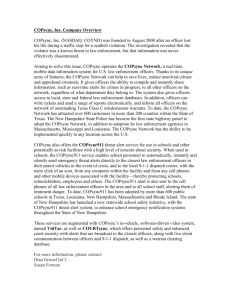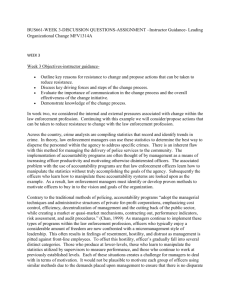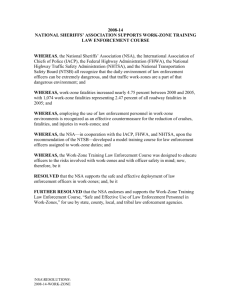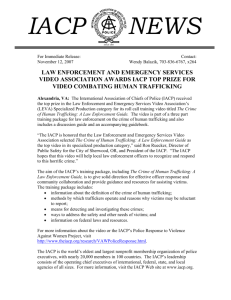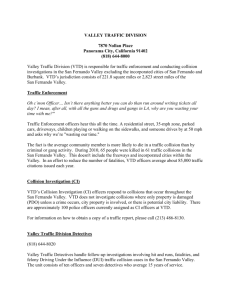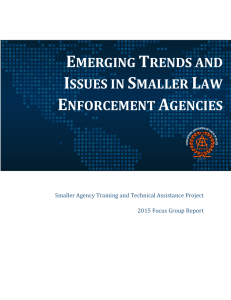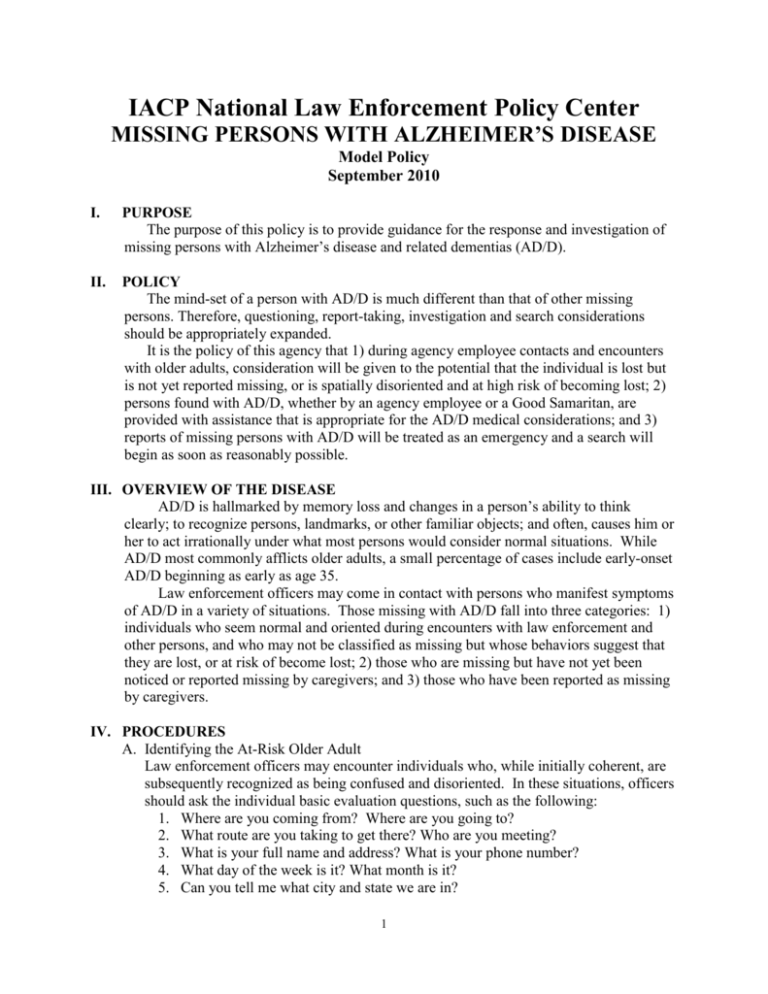
IACP National Law Enforcement Policy Center
MISSING PERSONS WITH ALZHEIMER’S DISEASE
Model Policy
September 2010
I.
PURPOSE
The purpose of this policy is to provide guidance for the response and investigation of
missing persons with Alzheimer’s disease and related dementias (AD/D).
II.
POLICY
The mind-set of a person with AD/D is much different than that of other missing
persons. Therefore, questioning, report-taking, investigation and search considerations
should be appropriately expanded.
It is the policy of this agency that 1) during agency employee contacts and encounters
with older adults, consideration will be given to the potential that the individual is lost but
is not yet reported missing, or is spatially disoriented and at high risk of becoming lost; 2)
persons found with AD/D, whether by an agency employee or a Good Samaritan, are
provided with assistance that is appropriate for the AD/D medical considerations; and 3)
reports of missing persons with AD/D will be treated as an emergency and a search will
begin as soon as reasonably possible.
III. OVERVIEW OF THE DISEASE
AD/D is hallmarked by memory loss and changes in a person’s ability to think
clearly; to recognize persons, landmarks, or other familiar objects; and often, causes him or
her to act irrationally under what most persons would consider normal situations. While
AD/D most commonly afflicts older adults, a small percentage of cases include early-onset
AD/D beginning as early as age 35.
Law enforcement officers may come in contact with persons who manifest symptoms
of AD/D in a variety of situations. Those missing with AD/D fall into three categories: 1)
individuals who seem normal and oriented during encounters with law enforcement and
other persons, and who may not be classified as missing but whose behaviors suggest that
they are lost, or at risk of become lost; 2) those who are missing but have not yet been
noticed or reported missing by caregivers; and 3) those who have been reported as missing
by caregivers.
IV. PROCEDURES
A. Identifying the At-Risk Older Adult
Law enforcement officers may encounter individuals who, while initially coherent, are
subsequently recognized as being confused and disoriented. In these situations, officers
should ask the individual basic evaluation questions, such as the following:
1. Where are you coming from? Where are you going to?
2. What route are you taking to get there? Who are you meeting?
3. What is your full name and address? What is your phone number?
4. What day of the week is it? What month is it?
5. Can you tell me what city and state we are in?
1
6. What time is it right now? (Answer should be correct within one hour.)
B. If the individual does not provide correct answers to these questions law enforcement
personnel should secure the person at his or her current location and consult with their
immediate supervisor on appropriate actions. If a substantial degree of confusion and
disorientation is identified, the individual should be temporarily detained in a
reasonably comfortable setting and attempts made by officers to locate the individual’s
family or care facility. If these efforts are not successful, the person should be taken to a
local hospital or care facility as available.
C. Initial Report Taking
1. There is no waiting period for reporting a missing person with AD/D.
2. The initial report taker shall gather information in order to initiate a response
appropriate for the situation. Such information includes the following:
a. Name, age and physical description of the person; a recent photo, if
available; and the relationship of the reporting party to the missing person.
b. Time and place of last known location and description of the clothing the
person was wearing when last seen. Ask if the clothing is weather
appropriate.
c. The extent of any search for the person currently being undertaken.
d. Whether the person has been missing on prior occasions and where the
person has gone in the past or where they were located previously.
e. The current physical condition of the person and whether the person is
taking prescription medication or has a co-existing medical condition. If
the person takes medication, when was the last dose taken and how long
can the person be without it without experiencing life-threatening or other
serious consequences.
f. Which door or exit did the person leave from?
g. Did the person leave on foot or in a car?
3. In addition, the following questions should be asked:
a. Is the person carrying identification, medical alert devices, or similar
items?
b. Would the person recognize and respond to police officers or someone in
uniform? Would the person be fearful of police or uniforms for any
reason?
c. Does the individual have weapons or access to weapons?
d. Is the current location near the person’s hometown – could the person
have gone to a former residence, workplace, church, or other familiar
location?
e. What is the person’s general daily routine?
f. Can he or she still use money and does he or she have any with him or
her? Is he or she capable of accessing cash?
g. What neighbors does he or she know well?
h. Are there activities he or she seeks out or enjoys? What would he or she
find interesting as it relates to locations?
i. Does he or she know how to use public transportation? Does he or she use
it regularly?
j. Does the person still remember his or her address or phone number?
2
k. Is the person drawn to certain landmarks, buildings, or objects?
l. Will the person go away from the sun or towards it?
m. Does the person have fears of crowds, strangers, or certain environments?
D. Preliminary Investigation
1. Responding or assisting officers should do the following:
a. Conduct a full search, as soon as reasonably possible, of the home or care
facility and surrounding premises and curtilage, including unusual
locations such as false ceilings, A/C venting, toy-boxes, sink basins or
cabinets, and so forth. A search of neighbors’ yards should also be
conducted.
b. Initiate a broader search if a thorough search of the home and immediate
area is unproductive.
c. Upon verification of a missing person, complete a “missing – critical” or
endangered missing persons report and initiate an alert if Silver Alert,
Endangered Persons Alert, or similar alerts exist in the area or jurisdiction
where the person has been reported missing. Make appropriate entries in
state and national information databases in accordance with established
procedures (e.g.: adjacent jurisdictions, state or commonwealth
department of public safety, National Crime Information Center, fusion
centers, and LEADS).
d. Check for indications of missing personal belongings, particularly money
and other valuables.
e. Check for any suggestion of foul play or accident.
f. Secure the premises or area where the person was last seen as a crime
scene.
g. Request that one person with whom the missing person is familiar remain
at the place last seen in the event the person returns and to serve as a
consistent point of contact.
2. In the case of persons designated as “missing - critical,” a supervisory officer may
do the following:
a. Request or assign a specific dispatcher to handle calls relative to this case
and direct the dispatcher to broadcast all relevant information necessary to
identify the missing person to all persons on duty.
b. Request that the shift commander authorize mobilization of resources
necessary for an area search.
c. Establish an Incident Command Center and implement the Incident
Command System.
d. Determine whether to use local media to help locate the missing person
and use where deemed necessary with the approval of the law enforcement
supervisor and the missing person’s family.
e. Determine the best use of developed communication networks: BOLOs,
texting programs, social media, reverse-calling systems, fusion centers,
and other outlets.
f. Conduct outreach through other governmental/contracted employees with
radios and vehicles such as parks/facilities, road crews, waste
management, and related personnel.
3
E. Search and Operational Considerations and Guidelines
Law enforcement officers should understand that standard grid-style searches may not
be useful with a missing AD/D person. Instead, officers should determine if the person
left by car or on foot.
1. If by car, officers should:
a. Ascertain or approximate the amount of fuel in the vehicle and construct a
search radius using this information. If the fuel cannot be approximated,
begin a routine search with a 5-mile radius using available officers and
volunteers.
b. Notify adjacent counties.
c. Initiate credit card and/or bank inquiries to determine if and where
purchases have been made since the person was last seen.
2. If on foot, officers should:
a. Begin a thorough foot search with a 1.5-mile radius using available
officers and volunteers.
b. Consider the dominant-hand theory: the person will follow the path of
their dominant hand, that is, if the person is right-handed, he or she will
likely be making right turns, following right, etc.
c. Call in other available assets, such as search helicopters, volunteer teams,
social services, etc.
d. Search areas of thick vegetation, near bodies of water, and near highways;
areas that have cover (natural or man-made), and residential yards.
Special attention should be paid to areas such as culverts, drainage areas,
wooded transitional areas between housing developments, etc.
e. Consider obscure hiding locations: junkyards, drainage trenches, building
roofs, abandoned buildings and vehicles, commercial ventilation
systems/ducts, etc.
f. Canvass area businesses and other easily accessible buildings.
g. Expand radius as time and weather dictate.
3. Search considerations:
a. Searchers should be aware that missing persons with AD/D likely will not
respond to their name being called. Missing persons may perceive that
they are “in trouble” and further hide or seclude themselves.
b. If the person is located, those having initial contact with the person should
do the following:
(1) Use low, calm voices and short, simple sentences or questions
(2) Clearly identify themselves and explain what they are doing
(3) Ask permission before touching
(4) Use simple instructions and positive reinforcement
(5) Allow plenty of time for the person to respond
(6) Limit volume of radios and curtail the use of lights and sirens, if
possible and practical, as this may further agitate the person
(7) Avoid placing the person in handcuffs (in cases of arrest) and use
caution when placing the person in a cruiser
F. Ongoing Investigation
4
Ongoing investigations of missing persons with AD/D should include, but should not be
limited to, the following:
1. Requests for the release of dental records and fingerprints, if available.
2. Contact with hospitals and the coroner or the medical examiner’s office as
appropriate for injured or deceased persons fitting the description of the missing
person.
3. Continuance of on-going contact by the lead investigator with the missing
person’s closest relative or responsible party and the assigned dispatcher
concerning progress of the investigation.
G. Recovery of Missing Persons and Case Closure
1. Upon location of a missing person, all agencies and information systems
previously contacted for assistance shall be notified or updated.
2. Missing persons and their caregivers shall be questioned to establish the
circumstances surrounding their disappearance and how future incidents might be
prevented.
3. The case report shall include a detailed report on the person’s whereabouts,
actions and activities during the investigation.
4. After Action Reports (AARs) shall be prepared, and a post-incident briefing shall
be conducted to establish Lessons Learned.
5. In cases involving licensed care facilities, officers shall ensure that:
a. The facility has taken proper precautions to prevent future incidents.
b. Proper reports have been filed to the facility’s chain of command – state
accrediting agencies, corporate office, insurers, and others.
6. Where indicated, follow-up action shall include filing an abuse and neglect report
with the appropriate state agency.
7. Where indicated, criminal charges shall be filed with the prosecutor’s office.
8. In cases of death, investigative personnel shall follow-up with the coroner’s office
in determining the cause of death and identifying available evidence.
Acknowledgment
This document was developed by the Advisory Board of the Missing Alzheimer’s Disease
Patient Initiative in conjunction with the IACP National Law Enforcement Policy Center. We are
appreciative of clinicians, faculty members, subject matter experts, and the law enforcement
executives who shared their expertise.
© Copyright 2010. Departments are encouraged to use this policy to establish one customized to their agency and jurisdiction. However,
copyright is held by the International Association of Chiefs of Police, Alexandria, Virginia U.S.A. All rights reserved under both international
and Pan-American copyright conventions. Further dissemination of this material is prohibited without prior written consent of the copyright
holder.
Every effort has been made by the IACP National Law Enforcement Policy Center staff and advisory board to ensure that this model policy
incorporates the most current information and contemporary professional judgment on this issue. However, law enforcement administrators
should be cautioned that no “model” policy can meet all the needs of any given law enforcement agency. Each law enforcement agency operates
in a unique environment of federal court rulings, state laws, local ordinances, regulations, judicial and administrative decisions and collective
bargaining agreements that must be considered. In addition, the formulation of specific agency policies must take into account local political and
community perspectives and customs, prerogatives and demands; often divergent law enforcement strategies and philosophies; and the impact of
varied agency resource capabilities among other factors.
This project was supported by a grant awarded by the Bureau of Justice Assistance. The Bureau of Justice Assistance is a component of the
Office of Justice Programs, which also includes the Bureau of Justice Statistics, the National Institute of Justice, the Office of Juvenile Justice and
Delinquency Prevention, the Office for Victims of Crime, and the Office of Sex Offender Sentencing, Monitoring, Apprehending, Registering,
5
and Tracking. Points of view or opinions in this document are those of the author and do not necessarily represent the official position or policies
of the U.S. Department of Justice or the IACP.
6
Appendix A
Information for Families Caring for Individuals with AD/D
1. Research available identification and tracking systems and encourage use.
2. Install double-sided locks or disguise locks on doors to visually deter the person from
using them.
3. Disguise exit doors in the home with curtains, wrapping paper, posters, or other visually
distracting objects.
4. Place bells on doors and windows.
5. Remove the person’s car if he or she still owns one, and hide keys to other cars in the
household.
6. If possible, establish relationships with neighbors and exchange contact information in
case of emergency.
7. Establish a schedule and follow it consistently to avoid the person leaving to seek
something – food, bathroom, and so forth to avoid the person becoming agitated by a
schedule disruption.
8. Prevention strategies and suggested community outreach:
Since searches for missing persons with AD/D are expensive and exhaust many
resources, it is advisable to implement prevention techniques within the community:
a. Provide families caring for persons with AD/D in the home with information
outlining steps to take to prevent the individual from going missing.
b. Establish a voluntary registry program for at-risk persons:
(1) Offer the program at community events, and use both uniformed and
civilian volunteers to solicit people to register.
(2) Include fingerprints, recent photos, several contacts such as neighbors,
medical needs, routes, familiar places, and so on.
7

